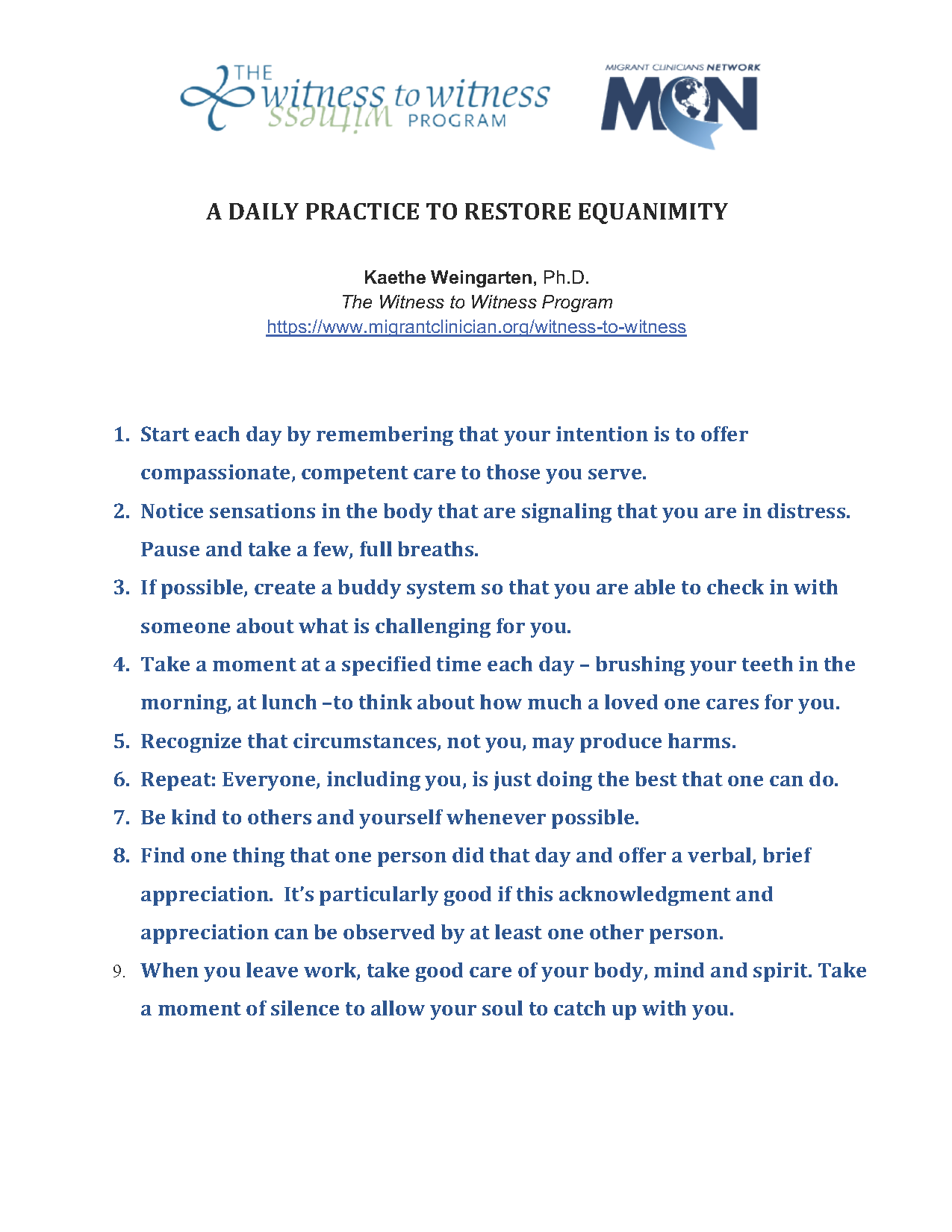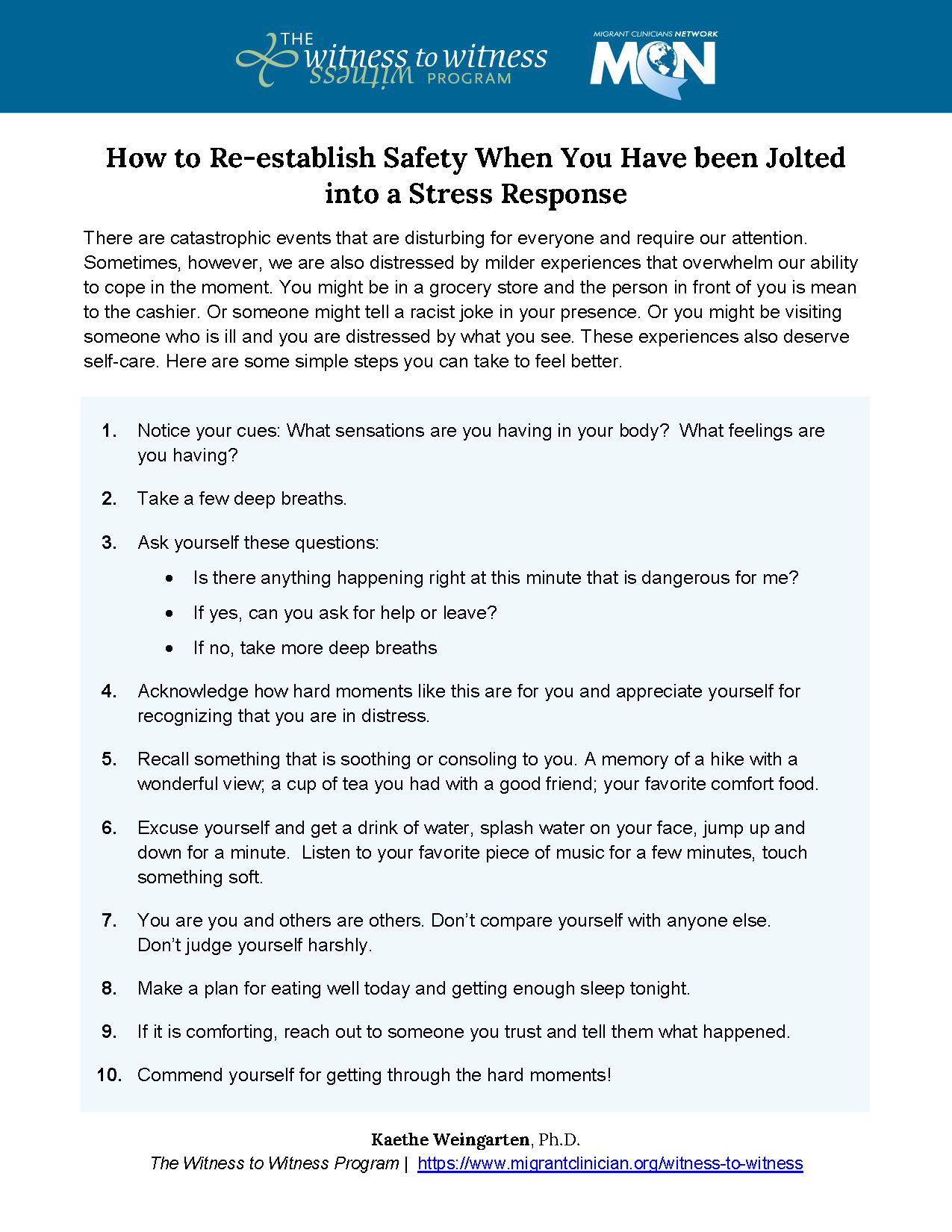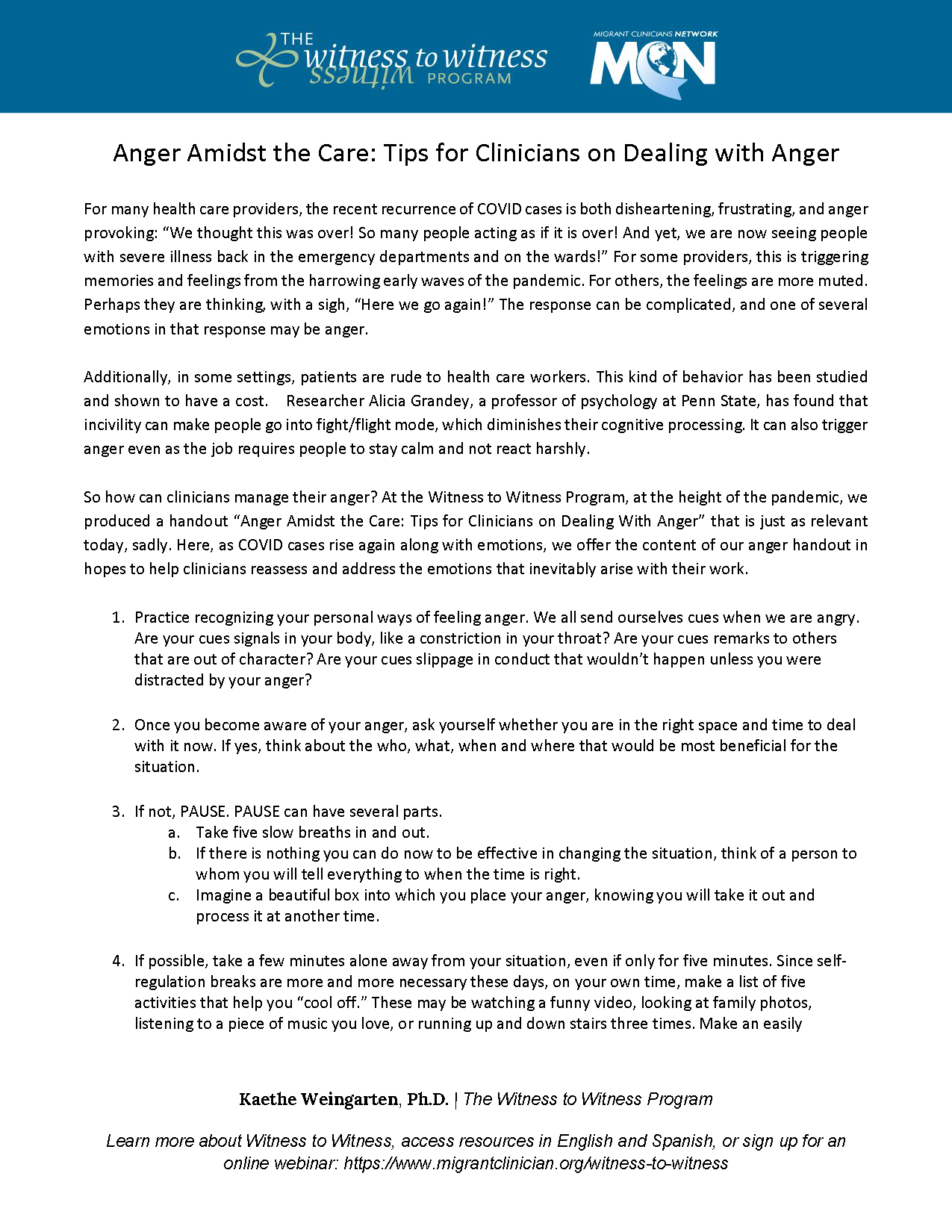
- 2023-5-9_I-Tested-Positive-COVID_Flowchart.pdf (105.16 KB)
- 2023-5-9_I-Tested-Positive-COVID_Flowchart.png (34.13 KB)
- 2023-5-9_He-dado-positivo-a-COVID19-Que-hago-ahora_0.pdf (106.22 KB)
- 2023-5-9_He-dado-positivo-a-COVID19-Que-hago-ahora_imagen_0.png (34.83 KB)
- 2023-6-30_Mwen-te-teste-pozitif-pou-COVID-19_Resous.pdf (102.83 KB)
- 2023-6-30_Mwen-te-teste-pozitif-pou-COVID-19_Resous.png (51.97 KB)
- 2022_Prioritize Fun.pdf (460.26 KB)
- 2024-08-05_Modèl_depliyan_sou-vaksen-COVID-pou Timoun1.pdf (601.66 KB)
- 2024-08-05_Modèl_depliyan_sou-vaksen-COVID-pou Timoun1.pptx (7.57 MB)
- 2024-08-05_Children-COVID-Vaccine-Trifold_Handout_Template1.pdf (638.71 KB)
- 2024-08-05_Children-COVID-Vaccine-Trifold_Handout_Template1.pptx (9.99 MB)
- 2024-08-05_Niños-COVID-Vacuna-Tríptico_Material-de-apoyo_Plantilla1.pdf (666.67 KB)
- 2024-08-05_Niños-COVID-Vacuna-Tríptico_Material-de-apoyo_Plantilla1.pptx (7.58 MB)

- A DAILY PRACTICE TO RESTORE EQUANIMITY.pdf (60.07 KB)
This resource provides parents with instructions on ways you can help prevent the COVID-19 virus from transmitting to children, including information about approved vaccines for each age group. Additionally, it provides resources for more information including places you can go to get your child vaccinated. This resource is available in pre-made and template format, and in three languages including English, Spanish, and Haitian Creole.
- 2024-08-05_Children-COVID-Vaccine-Trifold_Handout_Template1.pdf (638.71 KB)
- 2024-08-05_Children-COVID-Vaccine-Trifold_Handout_Template1.pptx (9.99 MB)
- 2024-08-05_Niños-COVID-Vacuna-Tríptico_Material-de-apoyo_Plantilla1.pdf (666.67 KB)
- 2024-08-05_Niños-COVID-Vacuna-Tríptico_Material-de-apoyo_Plantilla1.pptx (7.58 MB)
- 2024-08-05_Modèl_depliyan_sou-vaksen-COVID-pou Timoun1.pdf (601.66 KB)
- 2024-08-05_Modèl_depliyan_sou-vaksen-COVID-pou Timoun1.pptx (7.57 MB)
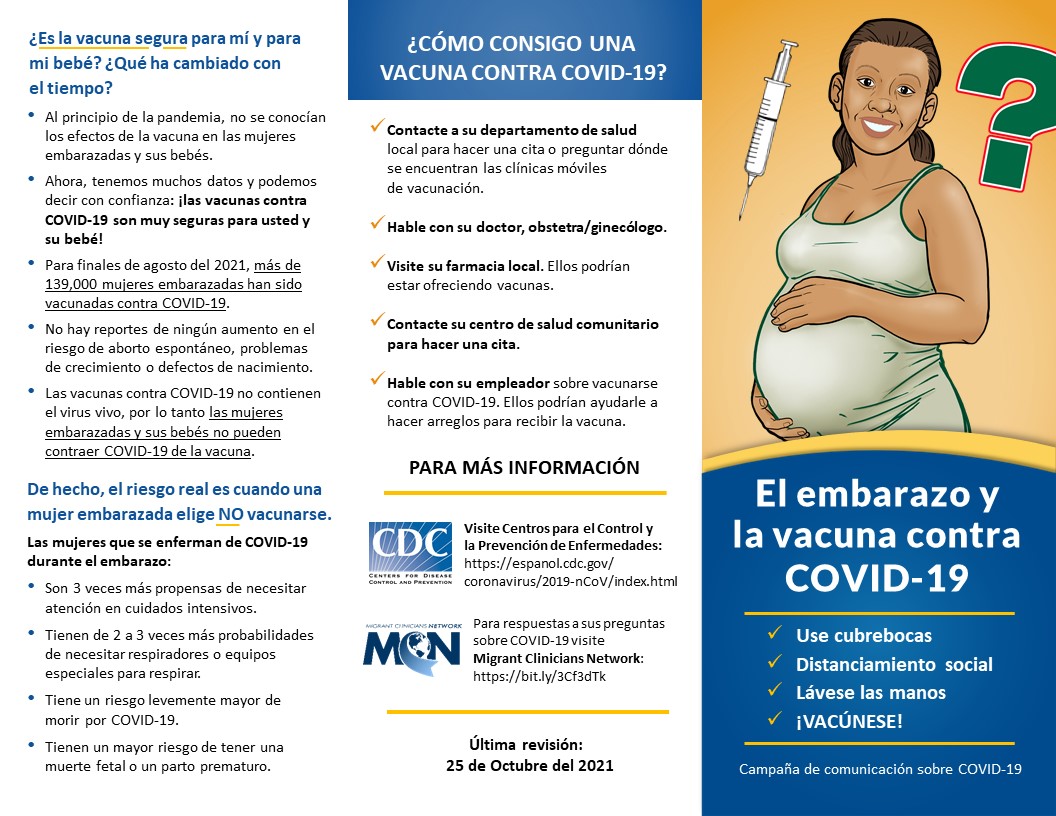
- 1-15-22_Spanish_Pregnancy-COVID-vaccine_Trifold_0.pdf (659.22 KB)
- 1-15-22_Spanish_Pregnancy-COVID-vaccine_Trifold-Template_0.pptx (9.05 MB)
- 1-15-22_English_Pregnancy-COVID-vaccine_Trifold_0.pdf (671.73 KB)
- 1-15-22_English_Pregnancy-COVID-vaccine_Trifold-Template_0.pptx (9.04 MB)
- 1-15-22_HaitianCreole_Pregnancy-COVID-vaccine_Trifold_0.pdf (654.59 KB)
- 1-15-22_HaitianCreole_Pregnancy-COVID-vaccine_Trifold-Template_0.pptx (9.02 MB)
This resource provides information regarding COVID-19 vaccination and pregnancy. It confirms that the COVID-19 vaccine is completely safe to receive before, during, and after pregnancy. Additionally, it provides resources for more information including places you can go to receive a vaccination, and overviews vaccine effectiveness and COVID-19 prevention. This resource is available in pre-made and template format, and in three languages including English, Spanish, and Haitian Creole.
- 2024-08-05_Pregnancy-COVID-Vaccine-Trifold_Handout_Template.pdf (548.41 KB)
- 2024-08-05_Pregnancy-COVID-Vaccine-Trifold_Handout_Template.pptx (9.65 MB)
- 2024-08-05_Embarazo-COVID-Vacuna-Tríptico_Material-de-apoyo_Plantilla.pdf (587.29 KB)
- 2024-08-05_Embarazo-COVID-Vacuna-Tríptico_Material-de-apoyo_Plantilla.pptx (9.65 MB)
- 2024-08-05_Model_depliyan_sou-vaksen-COVID-pou-fanm-ansent.pdf (548.78 KB)
- 2024-08-05_Model_depliyan_sou-vaksen-COVID-pou-fanm-ansent.pptx (9.64 MB)
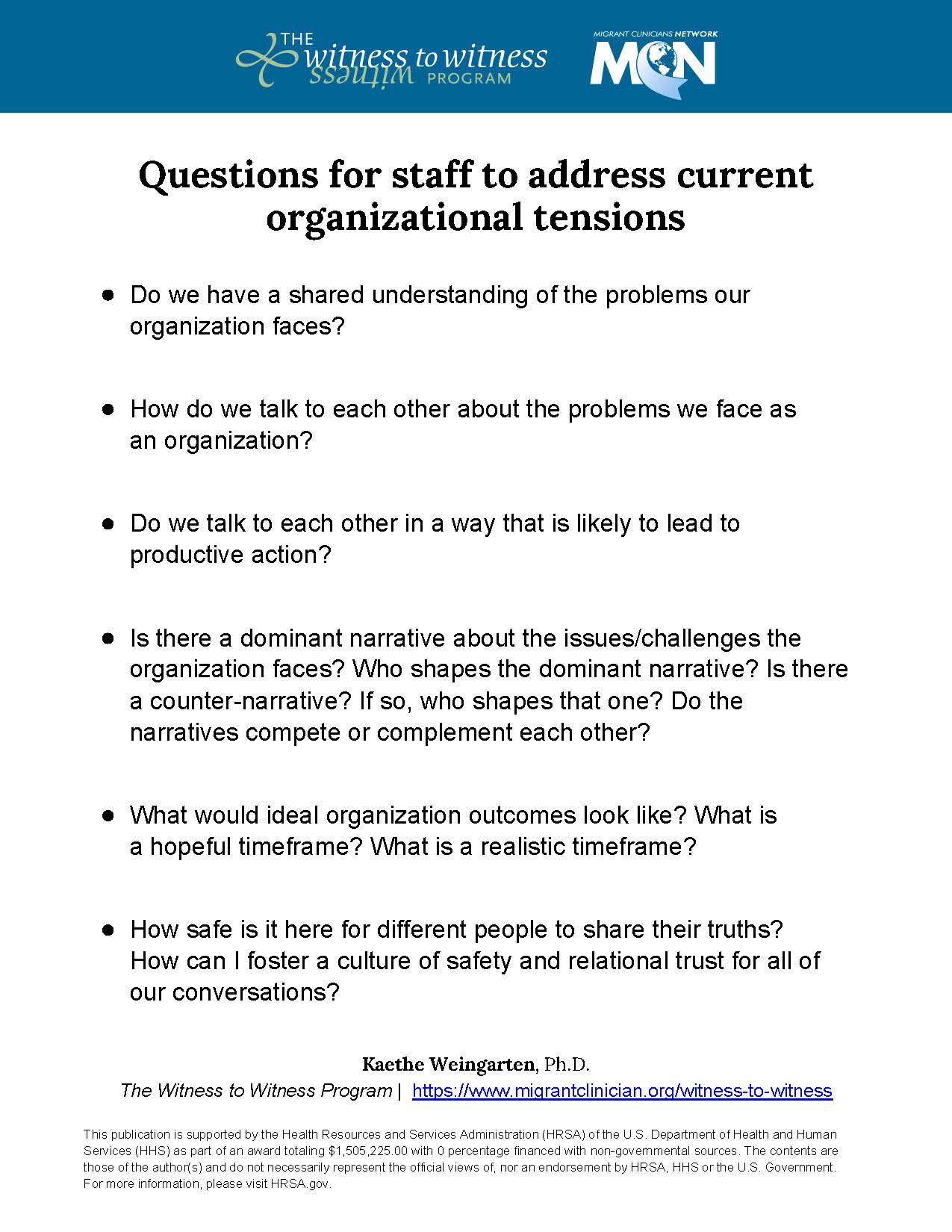
This publication was supported by the Health Resources and Services Administration (HRSA) of the U.S. Department of Health and Human Services (HHS) as part of an award totaling $ 1,310,460 with 0 percentage financed with non-governmental sources. The contents are those of the author(s) and do not necessarily represent the official views of, nor an endorsement, by HRSA, HHS, or the U.S. Government. For more information, please visit HRSA.gov.
- 2022-4-28_Questions-for-Staff-to-Address-Current-Organizational-Tensions_Handout.pdf (132.17 KB)
- 20D466~1.PDF (127.83 KB)

This resource provides information confirming the safety and effectiveness of the COVID-19 vaccine. It also includes recommendations for receiving the vaccine and COVID-19 prevention. This resource is available in pre-made and template format, and in three languages including English, Spanish, and Haitian Creole.
- 2024-08-05_General-COVID-Vaccine-Trifold_Handout_Template1.pdf (450.47 KB)
- 2024-08-05_General-COVID-Vaccine-Trifold_Handout_Template1.pptx (5.03 MB)
- 2024-08-05_General-COVID-Vacuna-Tríptico_Material-de-apoyo_Plantilla1.pdf (446.88 KB)
- 2024-08-05_General-COVID-Vacuna-Tríptico_Material-de-apoyo_Plantilla1.pptx (5.02 MB)
- 2024-08-05_Modèl_depliyan_sou-vaksen-COVID-Jeneral.pdf (413.37 KB)
- 2024-08-05_Modèl_depliyan_sou-vaksen-COVID-Jeneral.pptx (4.92 MB)
Guía del proveedor de servicios de salud para enfermedades relacionadas con el calor - Junio de 2021
Los trabajadores agrícolas corren un riesgo importante de sufrir estrés por calor. El estrés por calor se produce cuando el cuerpo no puede deshacerse del exceso de calor y su temperatura central aumenta. El estrés por calor puede dar lugar a enfermedades más graves relacionadas con el calor, como el agotamiento por calor, los calambres por calor, el golpe de calor e incluso la muerte, si no se trata. El trabajo agrícola, que requiere la realización de un trabajo físicamente exigente durante largas horas en un clima caluroso y a veces húmedo, pone a los trabajadores en alto riesgo.
Esta guía proporciona información a los proveedores de servicios de salud sobre la prevención y el tratamiento de las enfermedades relacionadas con el calor. Dado que los trabajadores pueden no estar familiarizados con todos los síntomas del estrés por calor, es importante que los proveedores de servicios de salud hablen con los trabajadores agrícolas y otras personas en riesgo sobre los síntomas de las enfermedades relacionadas con el calor y su prevención.
This joint FJ and MCN publication was supported by the Health Resources and Services Administration (HRSA) of the U.S. Department of Health and Human Services (HHS) as part of awards totaling $1,949,598 with 0% financed with non-governmental sources. The contents are those of the authors and do not necessarily represent the official views of, nor an endorsement by, HRSA, HHS, or the U.S. Government. For more information, please visit HHS.gov.
Agricultural workers are at significant risk for heat stress. Heat stress results when the body cannot get rid of excess heat and its core temperature rises. Heat stress may lead to more severe heat illness including heat exhaustion, heat cramps, heat stroke, and even death if left untreated. Agricultural work, which requires performing physically demanding work for long hours in hot and sometimes humid weather, places workers at high risk.
This guide provides information to clinicians on the prevention and treatment of heat-related illness. Since workers may not be familiar with all of the symptoms of heat stress, it is important that clinicians discuss heat illness symptoms and prevention with agricultural workers and others who are at risk.
This joint FJ and MCN publication was supported by the Health Resources and Services Administration (HRSA) of the U.S. Department of Health and Human Services (HHS) as part of awards totaling $1,949,598 with 0% financed with non-governmental sources. The contents are those of the authors and do not necessarily represent the official views of, nor an endorsement by, HRSA, HHS, or the U.S. Government. For more information, please visit HHS.gov.
- 2021_Heat-Stress_Clinicians-Guide_0.pdf (1.02 MB)
This colorful vaccine calendar comic gives low-literacy information on vaccines and some information on why adults need immunizations, too. Available in high resolution to download and print into poster size.
- Adults-Get-Vaccinated-Too_Calendar_2024-3-12_Digital.pdf (601.42 KB)
- Adults-Get-Vaccinated-Too_Calendar_2024-3-12_Print.pdf (25.06 MB)
- 2024-5-9_Adults-Get-Vaccinated-Too-Calendar_Template.pdf (50.52 MB)
- Los-grandes-tambien-se-vacunan_calendario_2024-3-7_Digital.pdf (603.02 KB)
- Los-grandes-tambien-se-vacunan_calendario_2024-3-7_Imprimir.pdf (53.41 MB)
- 2024-5-9_Los-grandes-tambien-se-vacunan_calendario_Plantilla.pdf (50.06 MB)
Worker Protection Standard Pesticide Safety Training Curriculum - Culturally and linguistically appropriate curriculum with supporting resources for training workers on the revised Worker Protection Standard. Developed by the Florida State University PISCA Project and Migrant Clinicians Network.
- WPS PesticidasEnglishFINAL4_2021Website.pptx (33.52 MB)
- WPS PesticidasSpanishFINAL4_2021_Website.pptx (19.67 MB)
- WPSPesticidesFlipChartFINAL_1_23_2020.pdf (8.32 MB)
- WPS Pesticide Facilitator Guide English 2020.pdf (2.03 MB)
- WPS Pesticide Training Facilitator Guide Spanish 2020.pdf (1.99 MB)
- Juan Abre los Ojos como protegerse de los pesticidas (01 14 2020)_0.pdf (7.25 MB)
This almost real-time map shows where COVID-19 cases have been reported, all over the world, which provides some perspective and allows for a visual understanding of the spread as it progresses.
NACHC’s new FAQ runs down a number of additional resources not covered here, specifically tailored for health centers.
HRSA’s new COVID-19 FAQs give some overview on the health center requirements around emergency preparedness as well as recommendations for communications from health centers.
Diabetes is a common but complicated health condition facing agricultural workers within the United States. To help assist agricultural workers in learning about this diagnosis, Migrant Clinicians Network has partnered with professional artist and collaborator Salvador Sáenz to create “Mi salud es mi tesoro: Un guía para vivir bien con diabetes,” or, “My Health is My Treasure: A Guide to Living Well with Diabetes.” This low-literacy comic book explores the topic through the full-color story of an agricultural farmworker named Goyo, whose recent diagnosis of diabetes prompts him to engage in conversations with other agricultural workers on topics of diet, exercise, and illness prevention while facing the unique hurdles of living a life of migration. The comic book was originally produced in Spanish, and is now available in English below. Please click "Leer en español" above to access the Spanish-language version.
In order to print the right number of comic books, we are asking organizations to pre-order in quantities up to 500. The comic book and shipping will be paid for by MCN. In exchange, we simply ask that you, or someone from your organization, complete an evaluation of the comic book several months after you first receive it. Information from the evaluation will help us improve our resources and will give us important insight into how the comic book is being used in the community.
Download a digital copy of the comic book below!
- 2022-6-13_My-Health-Is-My-Treasure_Comic_WEB.pdf (4.97 MB)
- 2022-6-13_My-Health-Is-My-Treasure_Comic_PRINT.pdf (38.95 MB)
- 2023-8-4_Mi-salud-es-mi-tesoro_Comic_WEB_0.pdf (4.87 MB)
- 2023-8-4_Mi-salud-es-mi-tesoro_Comic_PRINT.pdf (38.74 MB)
- 2023-8-21_Mi-salud-es-mi-tesoro_PuertoRico_Web_0.pdf (5.74 MB)
- 2023-8-21_Mi-salud-es-mi-tesoro_PuertoRico_PRINT.pdf (40.76 MB)
This new poll, taken by Migrant Clinicians Network in January and February 2018, reflected the experiences of clinical staff from 26 states across the country. Respondents came from every corner of the clinic; occupations listed include Physician, Executive Director, Dental Assistant, Outreach Specialist, Therapist, Community Health Worker, Registered Nurse, and 24 other occupations. The poll follows up on MCN’s 2017 poll, in which 63 percent of respondents indicated that immigrant and mobile patients’ attitudes and feelings toward health care access had changed.
- Poll Results February 2018.pdf (92.89 KB)
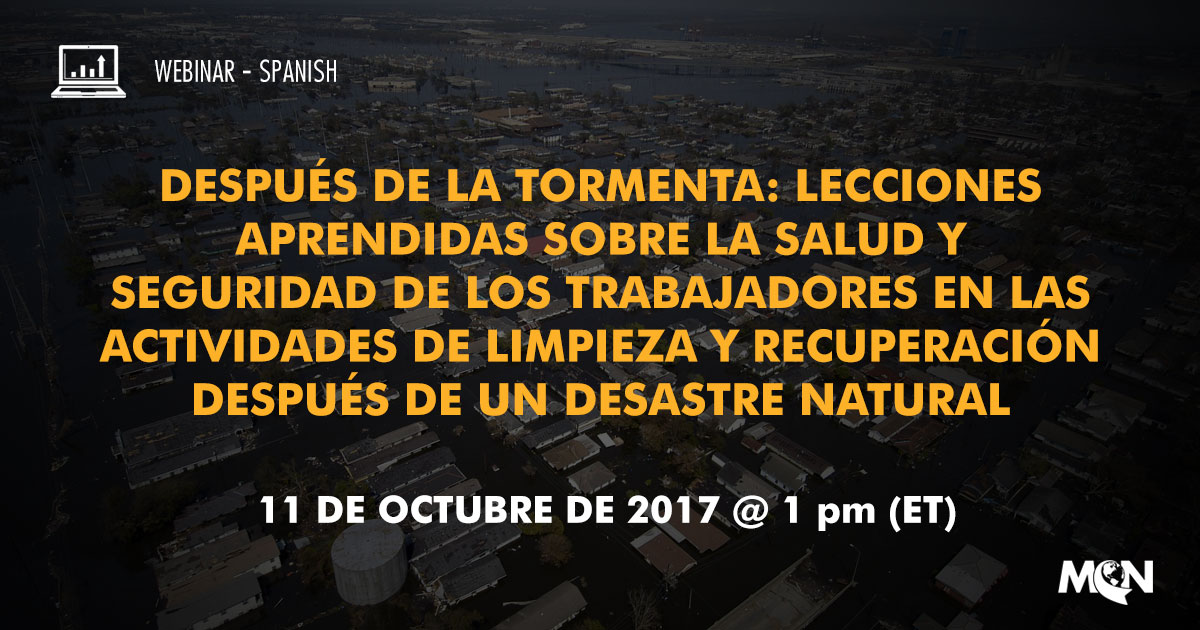
FECHA: 11 de Octubre de 2017 @ 1 PM (ET)
PRESENTADORES:
- Alma R. Galván, MHC, Migrant Clinicians Network
- Richard Rabin, MassCOSH
- Rossana Coto-Batres, MSW, Northeast New York Coalition for Occupational Safety and Health (NENYCOSH)
Crédito de educación continua
Para recibir credito de Trabajador/a de Salud Comunitaria o Educacion de Continua de Enfermera después de ver alguno de estos seminarios usted debe hacer lo siguiente:
- Completar la evaluación participante asociado a cada webinar
- Enviar un correo electrónico con su nombre y apellido indicando que ha completado a malvarado@migrantclinician.org
Descripción
Conforme las familias regresan a sus hogares en Houston, una vez que las inundaciones causadas por los Huracanes Irma y María se van retirando, esto se convierte en una carrera contra el tiempo. Un olor sofocante llena los cuartos de las casas, los charcos permanecen en los pasillos, y el moho se multiplica rápidamente. En cuestión de días, los patios ensopados de los vecinos se convierten en tiraderos de basura, conforme los trabajadores empiezan a quitar de las casas las paredes con moho, los pisos y los cielos destruidos, así como los muebles dañados. En este proceso, los trabajadores y muchos residentes se exponen al agua contaminada con químicos y basura, materiales de construcción peligros y alimañas dañinas. Pero hay otros riesgos adicionales, estructuras inestables y posibles intoxicaciones por monóxido de carbono de los generadores que trabajan incansablemente en espacios con poca ventilación. La exposición a asbestos, sílice y plomo son también peligros comunes para estos trabajadores.
Katrina, Sandy, Harvey, Irma y ahora Maria: son nombres de tormentas que nos indican las diferentes comunidades que terminaron bajo el agua, pero muchas de las historias emanadas de ellas, sobre la limpieza -- y los peligros involucrados-- son las mismas. Con resiliencia y determinación, las comunidades se tratan de reconstruir, pero la reconstrucción necesita una fuerza de trabajo inmediata, lista para este trabajo peligroso y extenuante.
Las operaciones de recuperación después del desastre, limpieza y reconstrucción presentan muchos riesgos y peligros para los trabajadores. Muchos de ellos realizan este trabajo sin el equipo de seguridad o el entrenamiento de mitigación de peligros adecuado.
En la recuperación de una supertormenta, ¿cuáles son las vulnerabilidades que los trabajadores enfrentan y qué significa eso para la seguridad y la salud del trabajador? Las siguientes preguntas surgen para los proveedores y trabajadores de salud comunitarios que cuidan y se preocupan por estos trabajadores: ¿cuáles son los puntos claves que necesitamos entender para poder cuidar de aquellos involucrados en estos esfuerzos de limpieza y reconstrucción? y ¿qué podemos hacer para que ellos mismos prevengan las lesiones y las enfermedades?
Este seminario en línea recupera experiencias obtenidas de desastres naturales anteriores y ofrece recursos que le pueden guiar en su trabajo. Ofreceremos casos reales para ilustrar los peligros y revisaremos formas en que los trabajadores se pueden proteger a sí mismos, incluyendo el entendimiento de sus derechos y responsabilidades.
Objetivos de aprendizaje
- Los participantes identificarán los peligros más comunes y críticos que los trabajadores y residentes encuentras cuando se involucran en la demolicion y reconstruccion despues de un desastre.
- Los participantes articularán las mejores estrategias para educar a los trabajadores y residentes sobre como prevenir lesiones y enfermedades durante las actividades de limpieza y reconstrucción después de huracanes y supertormentas.
- Los participantes enlistarán al menos tres recursos que pueden usar para guiar a los trabajadores y residentes durante la demolición y reconstrucción después de un desastre.
Este proyecto cuenta con el apoyo de la Administración de Recursos y Servicios de Salud (HRSA) del Departamento de Salud y Servicios Humanos de los Estados Unidos bajo el acuerdo de cooperación número U30CS09742, Asistencia Técnica a Centros de Salud Comunitarios y Migrantes y Personas sin Hogar por $ 1,094,709.00 con 0% del total Proyecto NCA financiado con fuentes no federales. Esta información o contenido y las conclusiones son las del autor y no deben ser interpretadas como la posición o política oficial de, ni cualquier endosos deben ser inferidos por HRSA, HHS o el Gobierno de los Estados Unidos.
Offers basic screening questions, common occupations and ailments associated with them, as well as recommended treatment. Also includes sample letters from clinicians to employers for restricted work.
This page highlights important tools for clinicians as well as diagnoses to consider when caring for disaster-affected patients.
California's Medical Supervision Program is a biomonitoring program that measures cholinesterase activity in bloog samples from agricultural workers. Employers are required by law to contract with physicians who have registered for this program, all of whom are included in this list.


